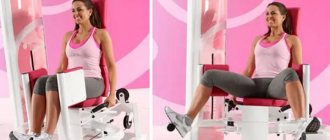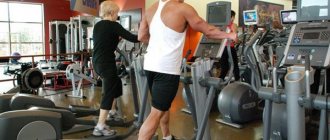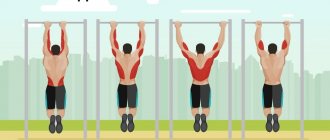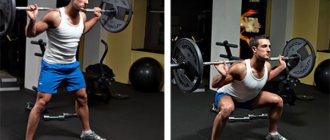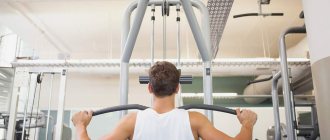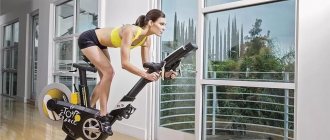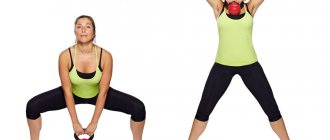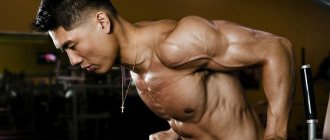Pros and cons of the exercise
Main advantages:
- Give a significant load on the chest and triceps.
- They involve a large number of muscle fibers (almost all groups of the upper body).
- The ability to progress endlessly, regardless of physical fitness level (using weights).
- Significant increase in strength and endurance.
- Building natural muscles and improving definition.
- Strengthening tendons and ligaments.
- Not only does it not create a negative compression effect on the vertebrae, but it also relieves muscle hypertonicity due to being in a hanging position.
- Another important feature of chest-style dips is that the pectoralis major receives additional stretching. This promotes muscle growth and improved posture (by turning the shoulders back).
The exercise has no obvious disadvantages , except for the need to perfectly follow the technique. Often athletes perform bench presses at a fast pace with an emphasis on the number of reps. This is only justified from a competitive point of view (when the goal is to do the maximum number of repetitions). For developing strength, mass and endurance, this option is less effective than concentrated movement at a moderate pace.
Advantages and disadvantages
Advantages
- Uses a large number of upper body muscles. Is basic.
- Availability of the exercise. Every gym has parallel bars. The same applies to street areas. Therefore, any athlete can find the time and place to perform this exercise.
- Helps strengthen tendons and ligaments.
- There is no compression load on the spine. Which makes the exercise more comfortable.
- Possibility of constant progression by adding weights.
- Push-ups improve relief and increase muscle endurance.
Flaws
Dips have no downsides, no matter how strange it may seem. If you adhere to the correct technique, then there is no question of injury. But one point can still be highlighted.
- For some beginners, the exercise may be difficult, especially at the beginning. But this is very easy to solve with the help of a gravitron simulator, a fitness band, or the help of a partner.
What muscles work when doing dips?
The parallel bar press is a basic exercise. This is a universal movement that is used to pump different muscle groups. Minor changes in technique can influence which muscles are used in dips.
- Chest muscles (mostly large).
- Triceps (emphasis on the long head).
These areas bear the main load (it can be changed by changing body position). Additional load and role in stabilizing the position of the arms and body falls on:
- Rotator cuff muscles.
- Front delts.
- Small pectorals.
- Serrated.
- Diamond-shaped.
- Trapezoid (lower part).
- Buttocks and abdominal area (work statically to stabilize the body).
The uniqueness of the movement lies in the fact that it applies to two different muscle groups at once. Despite the same type and similar technique, triceps and chest dips are different exercises.
Emphasis on the chest
Dips are great for both beginners and advanced athletes. Professional athletes can use additional weights, such as a weighted vest.
In order to focus the load specifically on the chest muscles, you need to understand exactly what functions they perform in our musculoskeletal system.
- The main purpose of the pectoral muscles is to bring the arms towards the body, bring them closer to each other and rotate them inward. Accordingly, in order to make these muscles work, you need to spread your arms (in our case, the elbows) wide, move them away from the body and make sure that the force of resistance interferes with bringing them back. This force is the weight of your own body.
- We also know that when performing chest exercises, depending on the angle observed between the torso and arms (arms perpendicular to the body, lowered down or raised up in front of the body), the corresponding part of the pectoral muscles receives the load. Since when performing push-ups on parallel bars, the arms are brought forward and lowered in relation to the body, the lower part of the chest receives the maximum load. By leaning our body forward, we also turn on the middle part. If we hold our torso completely upright or even lean back, the triceps take over the initiative, and the pectoral muscles work less.
The technique of performing the movement follows from the above. The chest style of push-ups will be described in detail below; now it is important for us to understand how the muscles work.
It is also worth noting that it will not be possible to completely exclude the triceps from the movement, since these muscles work in synergy with the pectoral muscles. Additionally, the shoulder muscles (deltoids) are also involved.
The exercise we are talking about is sometimes called wide-grip push-ups, by analogy with classic push-ups. However, the distance between the bars for doing push-ups should be slightly wider than shoulder width. This is due to the fact that if the width of the bars is too large, there is a high risk of injuring the shoulder joints, and if the distance is too small, it will not allow you to perform the movement. Therefore, the concepts of “wide grip” and “narrow grip” are very relative here.
The influence of grip width on muscle development
The width of the grip determines the emphasis of the load on the muscles.
- If the bars are wide apart, this is a variation of the parallel bars for the pectoral muscles. It is considered more technically difficult and requires better physical preparation.
- Dips to work the triceps are performed with a narrow grip. A simulator in which the crossbars are located closer to each other is suitable for this.
If there is only one exercise machine in the gym and on the playground and the width of the bars cannot be changed, the emphasis can be shifted to different muscles by tilting the body.
Wide grip dips
It is not entirely correct to consider the technique of push-ups on parallel bars with a wide stance of the arms as an option exclusively for the chest. This is due to the fact that a considerable part of the load falls on the front delta (as in other presses).
The technique is considered one of the most difficult, and therefore is not suitable for beginners (with weak muscles, you can easily get a sprain in the chest area).
Another difficulty when working with a wide grip is accessing the uneven bars. It also requires certain dexterity, technique and physical preparation, so beginners are always recommended to start with machines with narrow bars.
Close grip dips
This type of work is considered classic, regardless of goals and shifts in emphasis. With a narrow arm position, the athlete is able to perform more repetitions and sets, increasing training volume and efficiency. This ensures faster progression.
It is important to consider that, unlike wide-grip dips, narrower hand placement increases core stabilization. Shifting the emphasis to the chest or triceps in this case is done by changing the position of the body.
Execution technique
The starting position when performing the exercise is the “top point,” that is, emphasis on the uneven bars with straight arms. In the future, when lifting the body up, the elbows can not be fully extended, so as not to remove the load from the pectoral muscles.
So, the chest push-up style looks like this:
- Take the starting position on the uneven bars - with straight arms, with a grip slightly wider than shoulder width. Bend your legs at the knees and cross them so that they do not touch the floor.
- As you inhale, slowly lower yourself down, spreading your elbows to the sides. Try to tilt your body forward, bending your upper back. Lower yourself until you feel a good stretch in your pecs, but don't sag too far between the bars or you'll end up using your triceps to pull yourself up from the bottom.
- As you exhale, rise up under control, tensing your pectoral muscles as much as possible. Your task is to stretch your spine upward. At the top point, tighten your chest as much as possible and hold for 1-2 seconds. Do not press your elbows to your body.
- Lower yourself down again. Repeat the movement the required number of times.
When starting to master dips, do as many repetitions as you can. As your muscles get stronger, if your goal is to pump up your pecs, increase the number of repetitions to 10-15 per set, and do 3-4 such approaches. Once this load is not enough for you, use additional weights.
To get the best results and harmonious chest development, complement dips with other exercises: bench press, wide-grip push-ups, hummer presses, dumbbell flyes, pullovers, etc. Also pay attention to training the upper pectoral muscles. To do this, you can use, for example, an incline bench press (head up) or inclined push-ups with your feet above your head.
Technique for push-ups on the pectoral muscles
This exercise is recommended for developing the pectoral muscles. It gives a powerful load and additionally stretches the muscles.
Technique:
- Step onto the bars and get into position. Lean your body forward, tilting your head slightly. Bend your legs at the knees (this will further increase the degree of inclination).
- Begin to slowly lower yourself down without changing your body position. Movement occurs only in the shoulder and elbow joints.
- When your elbow is bent at a right angle, without pausing, return to the starting position, pressing your body up.
At the top point when working on the chest, it is recommended not to fully extend the elbow. This will reduce stress on the triceps and increase the efficiency of the movement for the target muscle.
Technique and types of push-ups
Standard plan for dips:
- The starting position is between parallel bars on straight arms. Grip – neutral (palms facing you)
- Taking a deep breath, begin to bend your elbows and slowly lower yourself down until your hands are at armpit level - this is the only way you will activate the triceps and pectoral muscles
- The pause in the lower position should not exceed two seconds. Rise up, straightening your arms. When you get past the hardest part of the climb, help yourself by exhaling.
- If you are unable to complete the full lift, do it to the maximum height available to you. Do not use weights until you can confidently go all the way down and up
Varying the technique, you need to shift the emphasis from time to time, either on the chest or on the triceps.
Dips with emphasis on triceps
To transfer the main load to the triceps, you need to keep your elbows close to your body (so that they look “back”). You cannot spread your elbows to the sides. The forward bend is minimal. Legs straight, slightly in front of you, chin raised. If the distance between the bars is greater than the width of the shoulders, then part of the load will inevitably transfer to the chest. Watch a video with an example of performing triceps-style push-ups:
Dips with emphasis on the pectoral muscles
We transfer the load to the main muscles of the chest - the pectoralis major. To do this, you need to spread your elbows to the sides while lowering, bend your knees and lean forward. The second way to engage your pecs is to widen your grip. But for this you need either bars with adjustable width or spread bars (installed in some gyms). The main thing in this matter is not to overdo it with the grip width, otherwise there is a risk of stretching or even tearing the joint capsule. The load will also shift to the latissimus, teres major and lower pectoral muscles. The best option is to use a grip slightly wider than shoulder width and spread your elbows out to the sides at an angle of about 45 degrees to the body; no more is needed. Below is a video example of chest style push-ups:
Dips with a pronated grip
A colossal load on your triceps is achieved when doing dips on the uneven bars with a pronated grip. We grab the bars with our palms facing away from us (our arms seem to be turned out) and perform push-ups, gradually increasing their depth, without leaning forward. For example, below is a video of such push-ups:
Triceps dip technique
This type of dip is used to shift the load on the triceps. The chest also takes part in the movement, but to a lesser extent than when tilting the body.
Technique:
- Exit and take the starting position. The arms should be fully straightened, the body forms a straight line, perpendicular to the floor.
- Slowly lower your body down, bending your arms.
- At the bottom point, take a minimal pause and return to the starting position.
Unlike the chest technique, in this variation it is important to straighten your elbows completely. This will allow you to maintain concentration on the triceps muscle and use it as much as possible during the movement.
Common mistakes in technology
We found out why push-ups on parallel bars are useful, and also warned that if performed incorrectly, the athlete can easily harm himself. Check out the most common mistakes that almost every beginner makes:
- Throughout the entire approach, you cannot round your back, even if you perform the option with a tilt of the body;
- Make sure your grip is tight and strong. The palm should not “ride” along the handle;
- Avoid jerking and sudden movements;
- Do not sag in the top or bottom positions;
- Do not straighten your elbows completely at the top.
Features of push-ups on uneven bars with weights
You should only switch to dips with additional weight after your bodyweight progression has slowed or stopped altogether. There is no point in performing a movement in a high-repetition style, except for competitions for the maximum number of repetitions or endurance training. If the goal is to increase strength or mass (for which weights are used), the greatest effectiveness will be achieved by working in a mode of 6 to 12 repetitions.
The technique when performing push-ups on uneven bars with weight does not change and depends on which muscle needs to be loaded:
- Chest – with the body tilted forward.
- Triceps - body in an upright position.
A weight or pancake is used as weights. The weight is hung on the belt using a hook or clamp immediately before the start of the set. Removed immediately after finishing the approach.
How to do push-ups correctly
PUSH-UPS FOR CHEST MUSCLES - VIDEO
Depending on the position of the body and arms when doing dips, we can shift the load towards the pectoral muscles or triceps.
To load the pectoral muscles, spread your elbows to the sides, move your body forward, do not straighten your arms completely in the upper position. The movement should be smooth throughout its entire amplitude. Avoid falling down uncontrollably as this may result in injury.
A video of correct chest dips can be viewed here
TRICEPS PUSH-UPS – VIDEO
To focus on your triceps, do dips while keeping your torso straight. Move your elbows back. Triceps work well on narrow bars - if you grab them with a grip slightly narrower than shoulder width. The pectoral muscles are more involved in the work if the bars are located at a distance wider than the shoulders and provide a wide grip.
A video of correct triceps dips can be viewed here
PUSH-UPS. BASIC ERRORS
- performing the movement too quickly. This is the biggest mistake when doing dips. To properly work out your muscles, try going down for a count: 2-3 seconds to move down, hold for a second in the lower position, then 2-3 seconds to go up. In the upper position, tighten your chest and triceps, this will give them additional stress.
How to do barbell curls correctly
- lack of warm-up. Dips without warming up can lead to strained pectoral muscles and injuries to the elbow and shoulder joints. The shoulder joint should be kneaded especially carefully - it is this joint that is most often injured when doing push-ups on the uneven bars. Pick up small dumbbells up to 2kg. Sit on a chair, bend your elbows - elbows at your torso, forearms parallel to the floor. Without changing the position of your elbows, move your forearms back and return to the starting position. Raise your arms bent at the elbows with dumbbells to the sides: move your forearms up and down. Rotate with your arms extended to the sides (without weights). Use elbow supports to prevent joint injury.
- too rapid progression of loads. Don’t rush to add additional weights to your dips. Hook the weight only after you can perform 20-25 repetitions at a slow pace with proper technique.
WEIGHTED PUSH-UPS
Additional weights are the main principle of muscle growth in dips. Use weights or dumbbell plates as weights. Hang them from your belt on a chain or a special belt (available in sports stores). If you don't have plates or weights available, you can use plastic water containers (5 liters or more) - fill them with water as you progress.
The Complete Guide to the Barbell Squat
Increase the weight of the weights as soon as you are able to complete the specified number of approaches and repetitions. The optimal number of repetitions per approach for muscle growth is 8-10. For relief – more than 10.
PUSH-UPS. TRAINING PROGRAM
A simple training program with a minimum of equipment might look like this. Train three times a week.
Day 1. Dips - 5 sets, until failure, additional weight. Push-ups from the floor (with a narrow position of the hands) - 4-5 approaches, until failure, additional weight. Bench push-ups for triceps - 4-5 sets to failure, additional weight. Handstand push-ups (feet resting on the wall) – 4-5 sets, until failure. Ab crunches – 3-4 sets of 30-40 reps.
Day 2. Wide grip pull-ups – 5-6 sets to failure. Reverse medium grip pull-ups – 5-6 sets to failure. Close grip pull-ups – 4-5 sets to failure. Archer pull-ups - wide grip, pull yourself up alternately with one hand and then with the other. 3-4 approaches to failure. Hanging leg raises – 3-4 sets to failure.
Day 3. Squats – 4-5 sets to failure. 50 times if you squat with your own weight, 10-15 times if you squat with a barbell. Walking lunges – 3-4 sets. Each approach is 2x25 meters. Squat jumps – 3-4 sets of 15 repetitions. Push-ups (regular hand placement) – 4-5 sets to failure. Scissors for abs – 5 sets of 20 reps (rest no more than 45 seconds between sets).
Attention! Before starting training, consult your doctor!
Dips with elastic band
There are two options for using rubber bands.
- One allows you to ease the load in order to correctly do push-ups on uneven bars at a low level of physical fitness (used by beginners).
- The second option is used to increase the load (instead of weights).
To reduce the load
- Secure the rope between the beams so that it hangs in the form of an open loop.
- Step onto the parallel bars and lower your shins onto the rope. This will relieve some of the stress from pushing the body out and make movement easier.
To increase the load
Hook the ends of the rope onto the bars, passing the loop over your shoulders behind your neck. When performing movements in the negative phase, the tourniquet will create additional resistance.
Choose a band with a tension level that is appropriate for your fitness level. Read more about elastic bands for pull-ups →
General Tips
Warm up well to avoid injury.
For beginners in sports who practice on parallel bars, you can try to perform only a standard bench press to get used to it.
For girls, standard dips and presses are better suited, instead of deviations and grip changes.
Push-ups come first in order to, to a greater extent, adapt the muscles to the next load, rather than the joints. The most trivial but important rule is that you train for yourself, not for someone else. This means that every repetition must be of high quality. Don't sag in your pace. Breathe. There is no need to hold your breath when performing difficult tasks. This will destroy your body before you even reach the end of the first circle. And drink water during your workouts. This technique will not only improve your performance during training, but also improve the result after it.
Reverse grip dips
This is a difficult technique that should only be attempted once the lifter can perform 4-5 sets with perfect form without weight. This option puts a lot of stress on the triceps , and also involves the forearms (than with regular push-ups).
Features of execution:
- The general technique does not change, except for the position of the hands (reverse or pronated grip).
- It is recommended to avoid full range of motion initially to minimize injury. Start with partial range of motion, gradually increasing the extension of the arm at the elbow.
- Do not lean your body forward. Try to perform the movement so that your body remains upright.
The number of push-ups on the uneven bars. Weight gain
The usual number of repetitions for one approach is 8-15 times. Additional weight should be added if you are comfortable doing more than 15 reps per set (many bodybuilders do no more than 8 reps with weights). This is the basic law of increasing muscles and their strength.
Increase the weight in small steps. There is no need to immediately hang a 25-kilogram pancake on yourself - not only will you not be able to squeeze out even one repetition, but there is also a risk of injuring yourself.
Additional weight can be added in a variety of ways. For this purpose, special weights have been invented - for the arms or legs, in the form of a belt, to which an additional load is attached (weights from a barbell, dumbbells) or a vest with special weights. The best option is a belt with a load:
Source: https://na-sporte.ru/
How can you replace dips?
If doing an exercise is contraindicated for medical or other reasons, then only safe movements that load the same muscle areas can replace it. For example:
- Bench press.
- Dumbbell bench press.
- Bringing the arm back while bending over.
- Close grip bench press.
- French presses.
Also, for athletes who cannot perform exercises on the uneven bars, these movements will serve as an excellent basis for increasing strength and technically correct execution of all elements.
What is better than dips, bench press, or floor push-ups?
Each exercise has its pros and cons. The clear disadvantage of parallel bars has always been the limiting factor in progression, since the movement was performed with the weight of one’s own body. However, in gyms and playgrounds, progression is ensured by push-ups on uneven bars with an elastic band or weights, so this disadvantage becomes irrelevant.
For the highest quality and full development of all muscle areas (from different angles), it is recommended to use all three exercises in the training program. The push-up option can be replaced with a bench press, since these are the same type of movements.
Recommendations
To make the exercise as effective as possible, you must adhere to the basic recommendations:
- It is important to understand which muscles are pumped in dips. This will allow you to perform the movement correctly.
- You must not allow yourself to fall down by inertia. This will not only increase the risk of injury, but will also reduce overall efficiency.
- The back should always be straight. Slouched shoulders or roundness in the upper back will place increased stress on the vertebrae and increase the risk of injury.
- Exhalation is always carried out during the upward movement.
Also, to increase the productivity of movement, it is necessary to concentrate tension on the muscles. This will improve neuromuscular communication and increase the overall benefits of exercise.
What muscles are involved?
Many athletes are interested in what dips do. And here we must report one interesting feature. This horizontal bar allows you to change the target muscle group by slightly adjusting the push-up technique. If desired, you can specifically load the triceps or just the pectoral muscles. There are also variations that require additional effort from the core muscles or a developed sense of balance.
It turns out that one simple simulator allows you to work out the entire upper shoulder girdle! So, what muscles are involved in the process of push-ups on uneven bars, let’s list:
- Triceps or triceps. It works in any subtype, but the athlete can adjust the load on it;
- Pectoralis major muscle. Subject to certain techniques;
- Front delts. Secondary load;
- Press;
- You can connect the biceps femoris and gluteus maximus if you bend your legs back and fix them in a stationary position;
- Stabilizer muscles;
Ligaments and joints also work actively. The elbow and wrist receive the heaviest load. They should be flexible and stretchable.
Dips are considered exercises with an increased risk of injury. If you have diseases associated with the condition of the joints, especially those mentioned above, it is better to avoid them. Below we provide a list of contraindications, as well as alternative types of physical activity.
